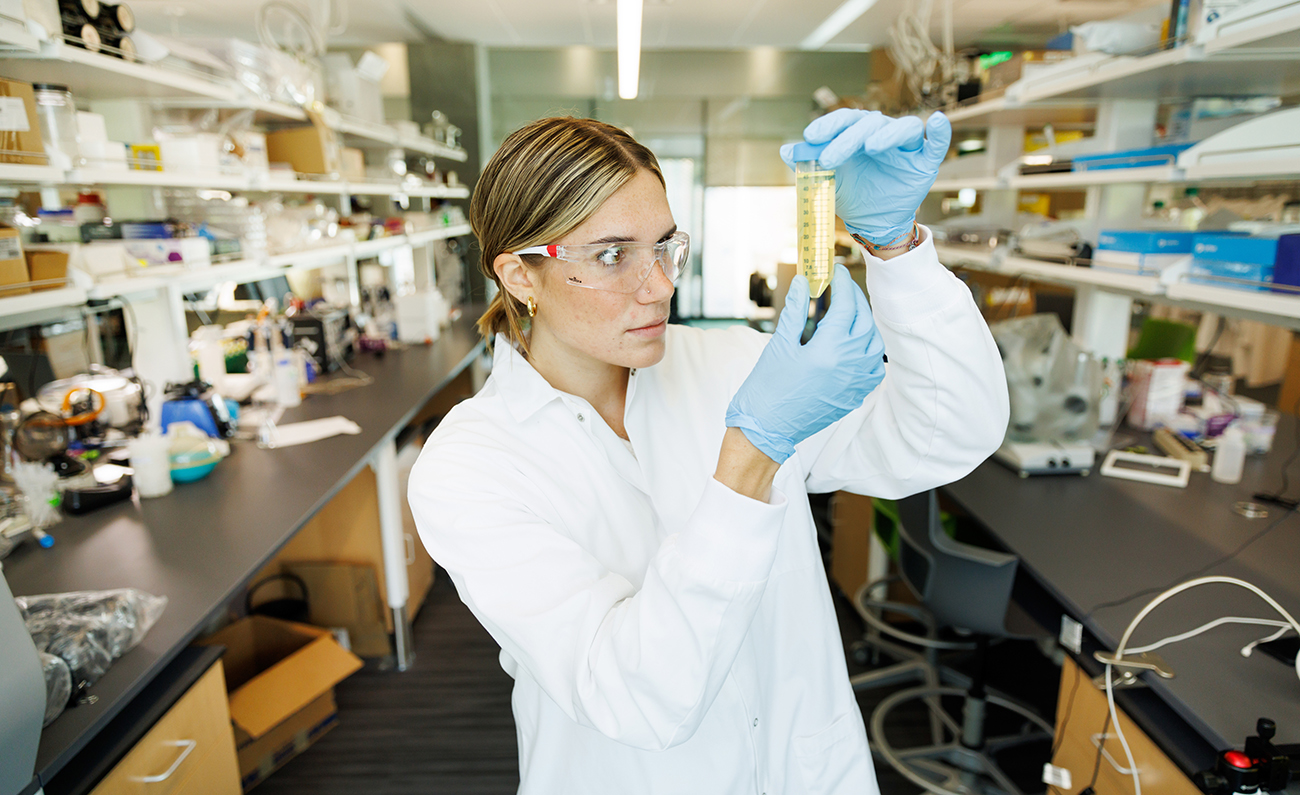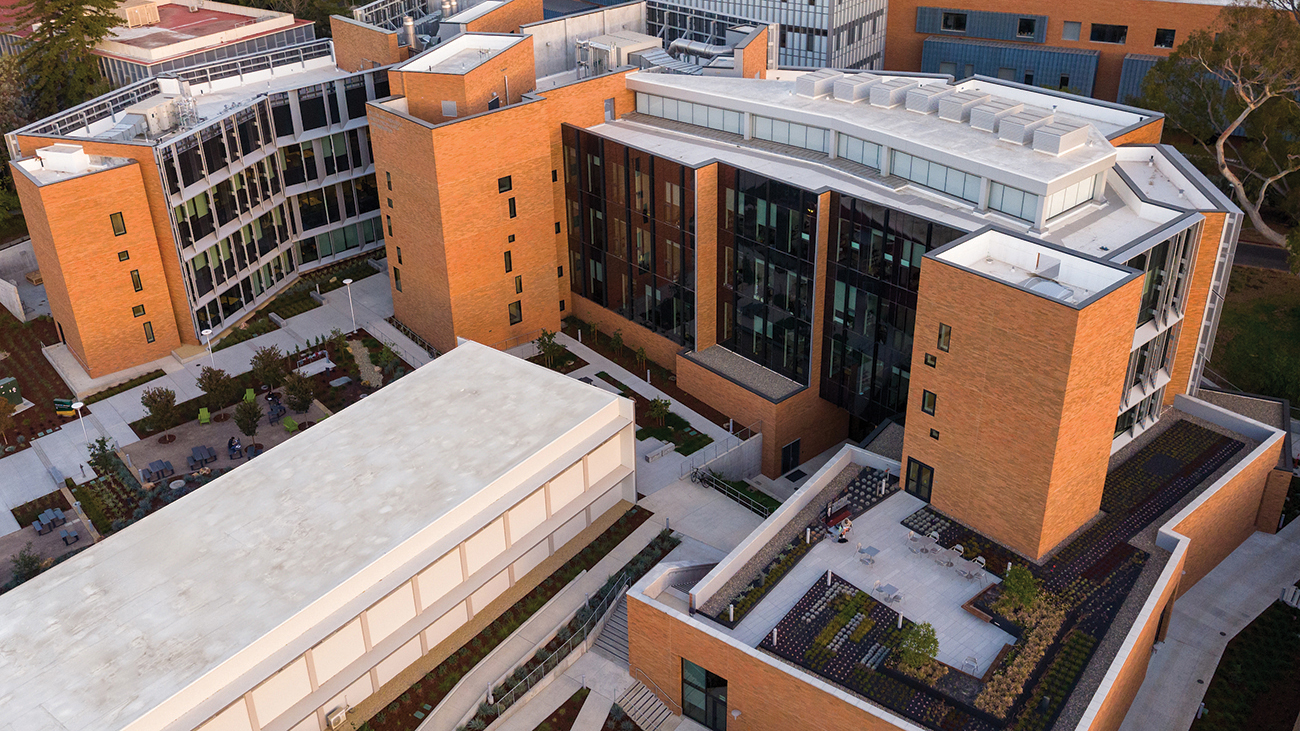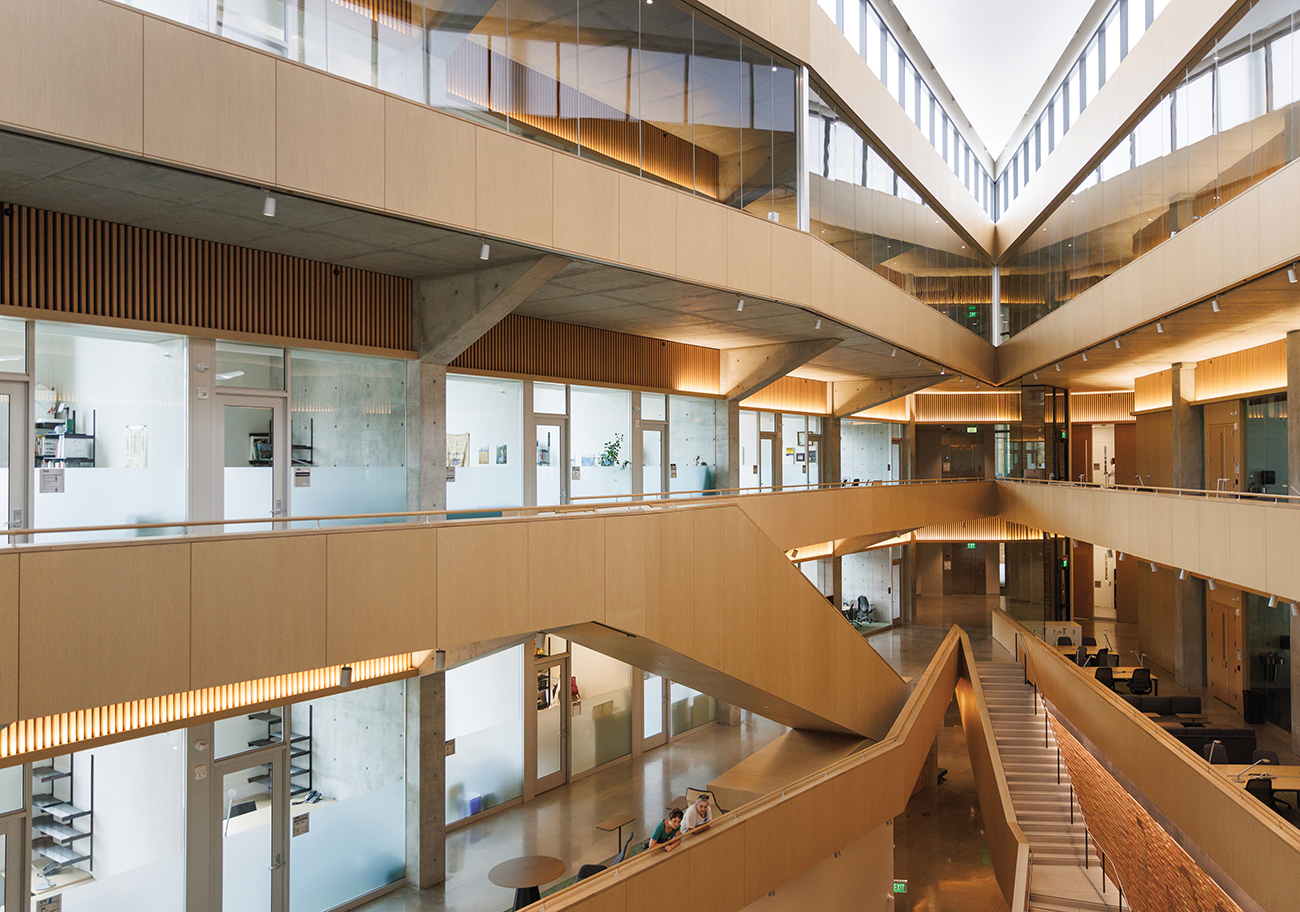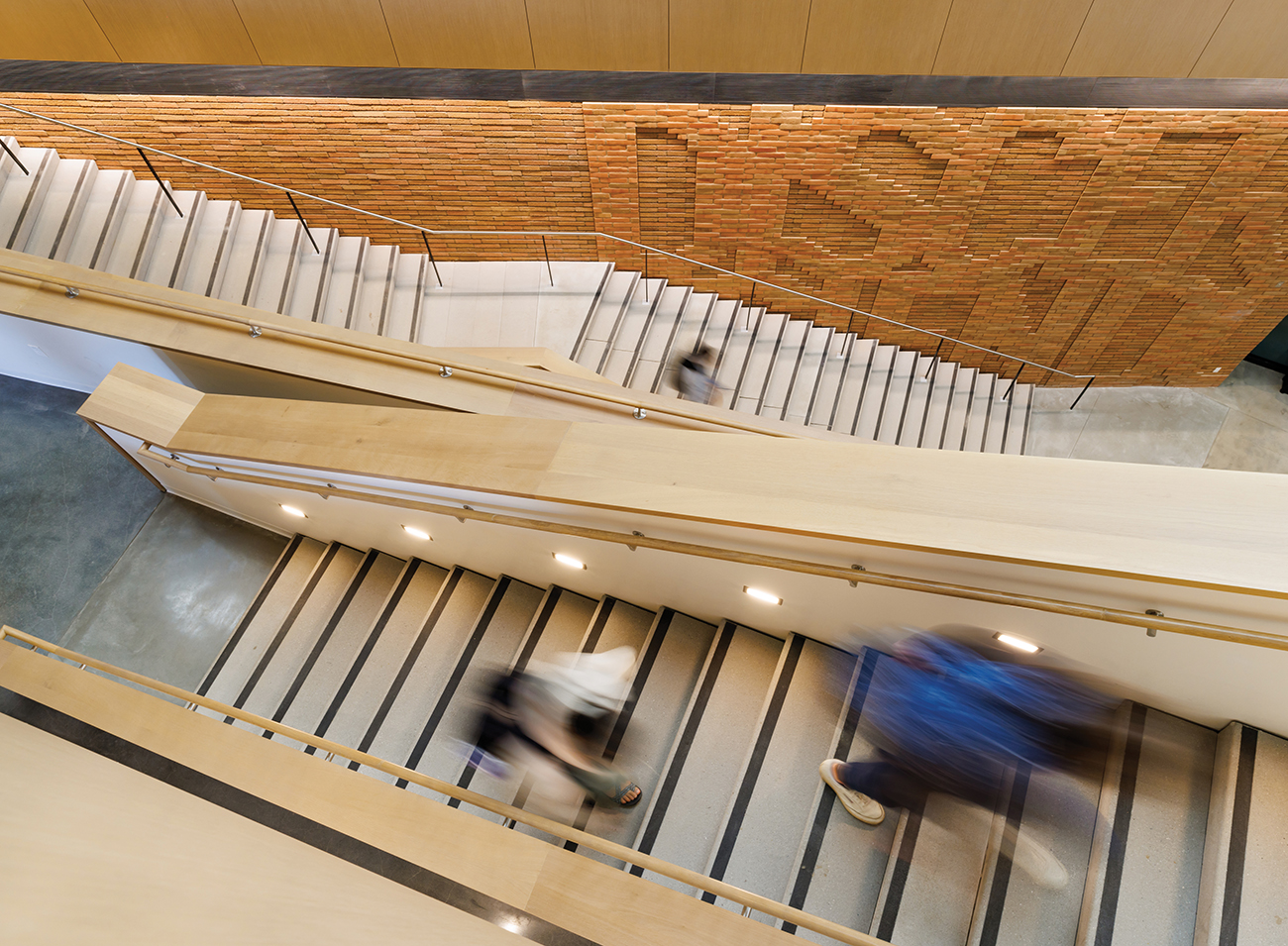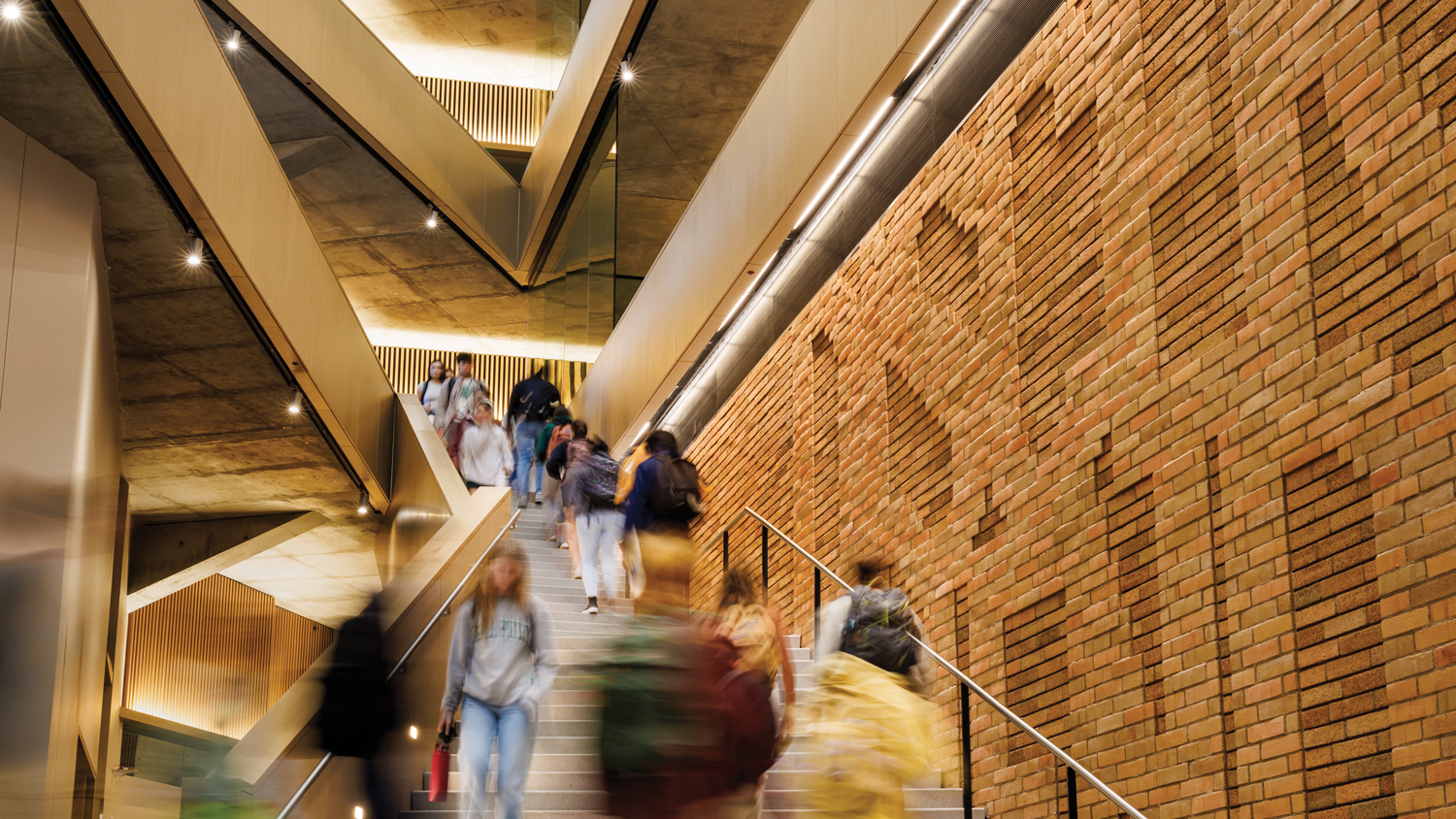
This spring, Cal Poly dedicated the newest hub for learning on campus: the William and Linda Frost Center for Research and Innovation. The new interdisciplinary research center features state-of-the-art laboratory and teaching spaces that enhance research and learning experiences for students and faculty in the Bailey College of Science and Mathematics; the College of Agriculture, Food and Environmental Sciences; and the College of Liberal Arts.
“This cutting-edge facility is an investment in the education and future successes of our students,” said William “Bill” Frost, a biochemistry alumnus whose generous gift made the building possible. “I look forward to this space being used to further enhance the Learn by Doing experiences that define Cal Poly for generations to come.”
The building is the new home for several important university research centers and facilities. The Center for Applications in Biotechnology and the Center for Coastal Marine Sciences have labs in the building. The Food Science and Nutrition Department has essential new spaces dedicated to culinary development, nutrition and food studies, sensory analysis and food safety in the building’s Boswell Agricultural Technology Center, and the Experience Industry Management Department has an Experience Innovation Lab to design unique user experiences. The Liberal Arts and Engineering Studies program has an impressive new facility in the Cashin Expressive Technology Studio.
And surrounding all these labs and research facilities are connected spaces for student collaboration; beautiful new offices for the interdisciplinary faculty associated with the labs; a stunning central atrium and event space where students can lounge and study; a rooftop garden that doubles as a learning lab; and a bright, appealing design overall that draws people together in the process of discovery.
Over the summer, Cal Poly Magazine got a chance to explore some of the center’s cutting-edge facilities and learn about what students will being doing there.
Don’t see the video above? Watch it on YouTube?
Center for Applications in Biotechnology
Big Questions, Tiny Subjects
Stopping a bacterial infection without antibiotics. Attacking a virus’s ability to replicate itself. Uncovering unknown causes of antibiotic resistance.
Each of these goals could help reshape the future of medicine, and faculty and student researchers are trying to find these answers in a suite of new laboratories in the Frost Center. They’re all part of the Center for Applications in Biotechnology (CAB), a consortium of interdisciplinary faculty conducting biology-related research. The new facility provides the group’s first central home on campus.
For the people doing this kind of research, the Frost Center laboratories are a game changer. Rather than working in multiple labs scattered across campus, CAB researchers now benefit from dedicated space, shared equipment and supplies, and close proximity to other labs — no small concern when jostling a cell sample you’re trying to transport could mean a major research setback.
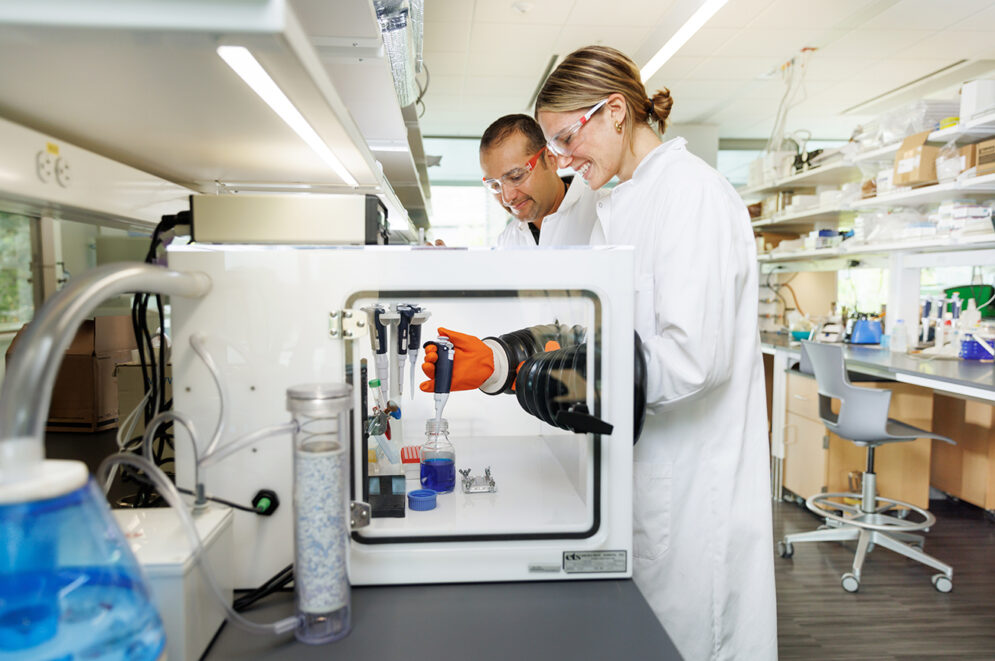
Biology student Claire Haats and biology professor Nathaniel Martinez working in Martinezʼ lab.
“Everything is now in one place, whereas before we had to go to different rooms to do different things,” says biology professor Alejandra Yep, whose lab researches how urinary tract infections develop. “It’s not only time consuming, but there’s also the chance for spilling contamination. You’ve got to be so careful when you’re carrying pathogens.”
For students working with CAB, the research experience can be a critical part of mapping their future careers.
“I’ve definitely had times in my undergrad career where I’ve debated pursuing a Ph.D. or pursuing research,” says pre-med biology student Claire Haats, who began working with biology professor Nathaniel Martinez as a Frost research fellow over the summer. “Having experiences like this has been great to help me make those career decisions and focus my interest. It’s just great to get different research experiences and explore different fields.”
And for faculty and students alike, the new facility provides an invaluable opportunity to collaborate and cross-pollinate ideas with researchers from different disciplines.
“I’m sitting here working next to chemists and marine biologists, and that day-to-day experience gives you more access to ask questions about what’s going on in the other labs,” says Martinez, who is researching novel antiviral treatments and point of care medical diagnostics. “I might have potential collaborations that we hadn’t thought about previously, just because now we have the time to say hi to each other every morning and inquire about those projects. I think that’s the whole point of Frost Center, and it’s already paying off.”
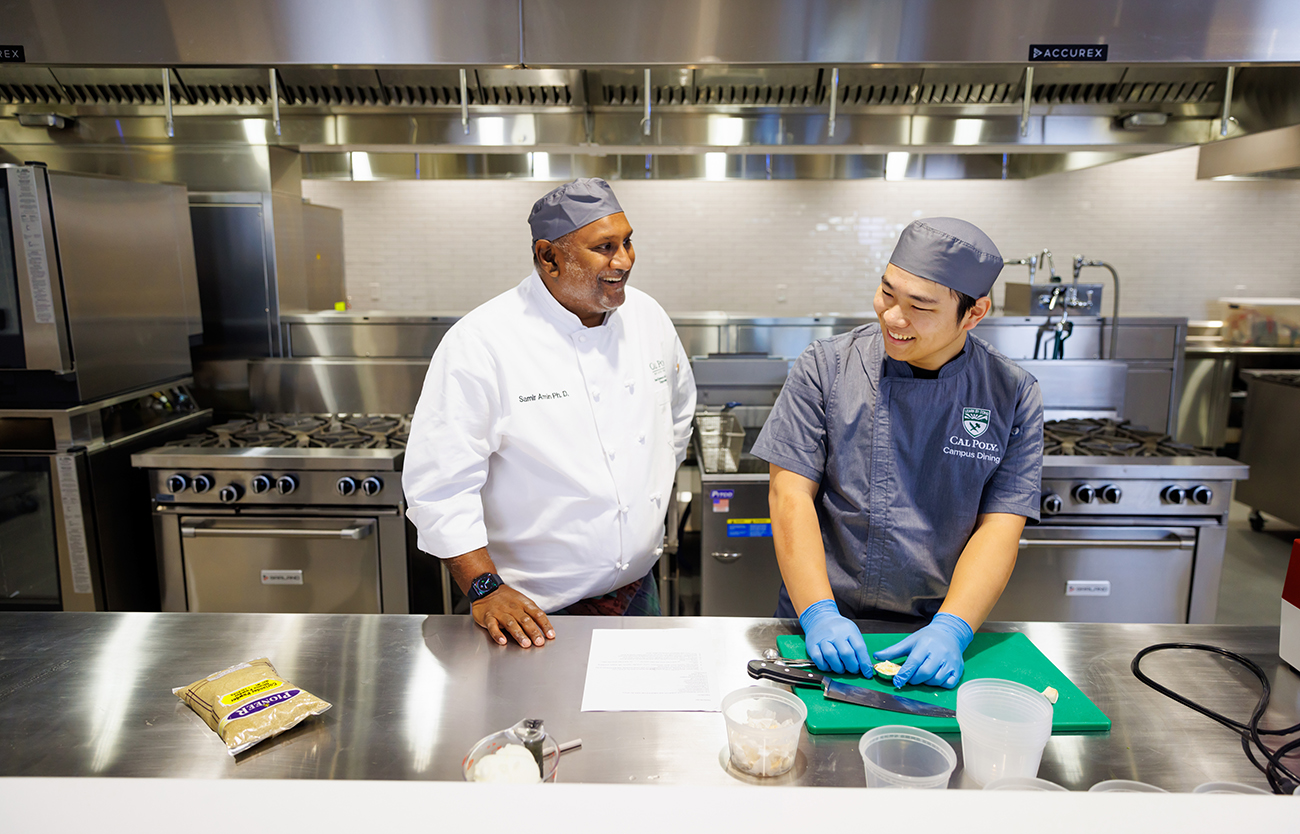
Associate professor Samir Amin and student Simon Lam.
Oreggia Family Foundation Culinary Lab
Now We’re Cooking
At a gleaming steel counter top, food science students Jack Madden and Simon Lam are slicing tofu, whisking flour and mixing bold spices under the eye of associate professor Samir Amin. A burner bursts into flame, a griddle sizzles, and a blender roars to life as a meal takes shape: tofu tikka masala and garlic naan.
“I grew up around restaurants, but one thing I’ve never cooked before is vegan food,” says Madden.
The new Oreggia Family Foundation Culinary Lab features eight state-of-the-art stainless-steel workstations where students learn how to prepare and serve food, create and modify recipes, and get ready for careers providing healthy, delicious meals to a growing array of consumers. The lab upgrades the previous space the department used in Building 24 with key components of a modern professional kitchen, like exhaust hoods and air fryers.
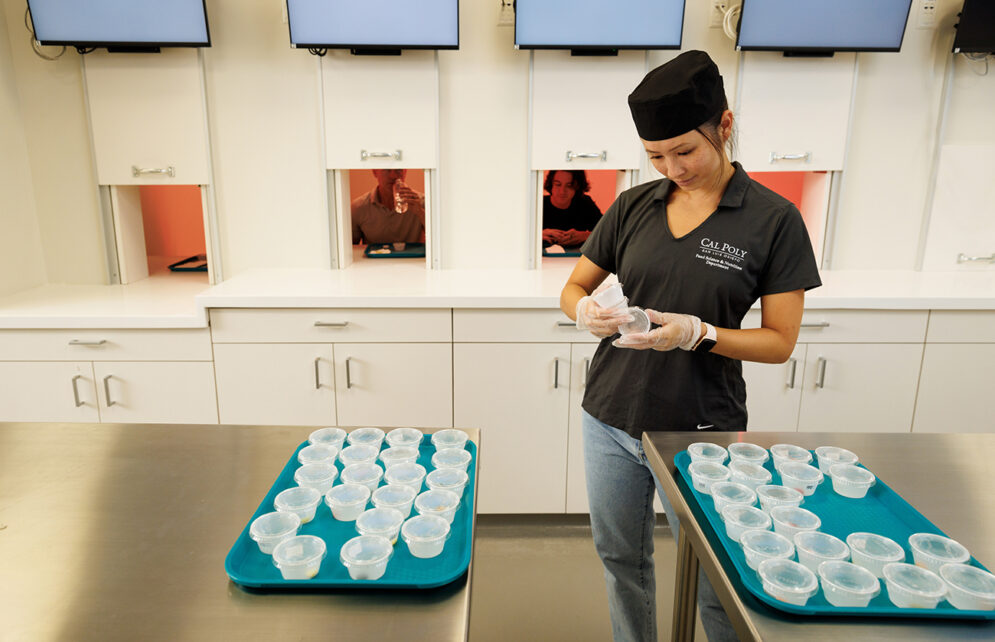
Food science grad student Julia Zoe prepares a sample for a taste test in the new sensory evaluation lab.
Another feature makes the kitchen worthy of a Food Network show: a cooking demonstration station equipped with a motion tracking camera, which displays an overhead view of the action on large projectors visible from the student stations and the first-floor atrium of the Frost Center.
“Coming from industry, I worked as a chef for a number of years and no kitchen I ever worked in was perfect, short of a Michelin three-star restaurant,” says Amin, who teaches many of the culinary classes held in the new space. “This is the closest I’m going to get to that, and I’m ecstatic about it. We can do so much here with our students.”
Next door, students can run taste tests in the professional-grade sensory analysis lab. The space features 24 tasting stations with controls designed to let subjects focus on flavor and texture, and interactive screens that let subjects record their responses in real time. The upgraded lab will allow students to run large-scale product development tests for real-world food manufacturing clients — earning money that the department can reinvest in student opportunities.
“They’re learning by doing, the students running tests in that space already — actual preparation for what they’ll be doing in the industry,” says Amy Lammert, a food science professor who runs the sensory lab.
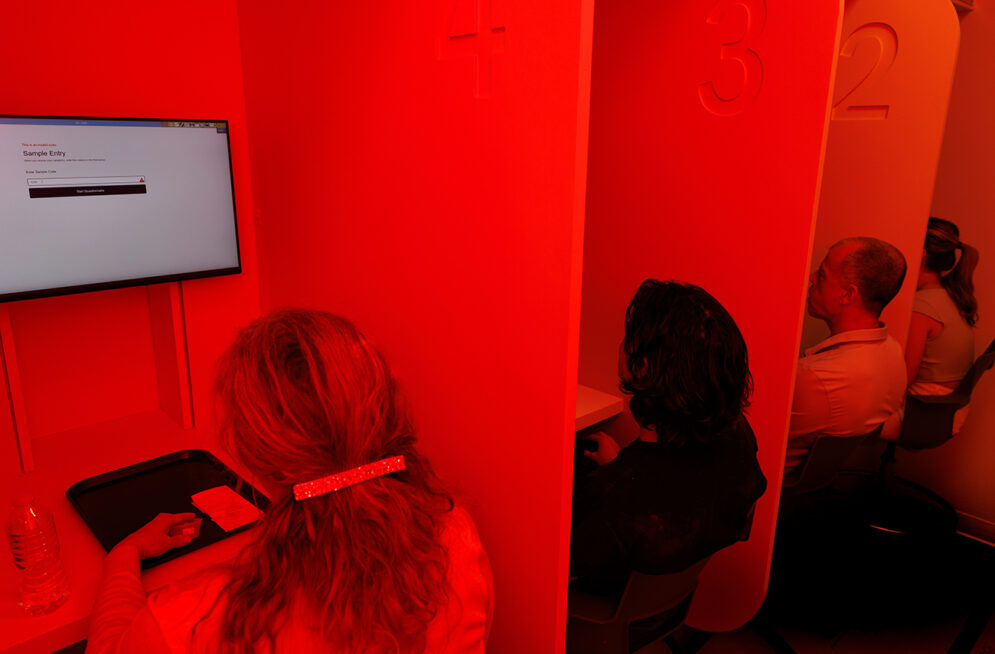
Subjects in the sensory analysis lab sample snacks under lighting conditions designed to minimize visual impact and maximize focus on flavor.
The culinary lab opens out onto the first-floor atrium of the Frost Center — a high-traffic area where everyone walking by will regularly be able to see, smell and even taste what the students are cooking in their classes. That visibility is a key part of the culinary lab, which was designed to invite the campus community to engage with the cooking process.
“Inviting people in is one of the most important parts, because everything you do in food science is based on the consumer,” says Madden. “Just being able to open the doors and say, ‘Hey, free food if you guys want to try it,’ and seeing what people think — that’s what I’m really looking forward to.”
Read more about the lab in the latest issue of Cultivate Magazine.
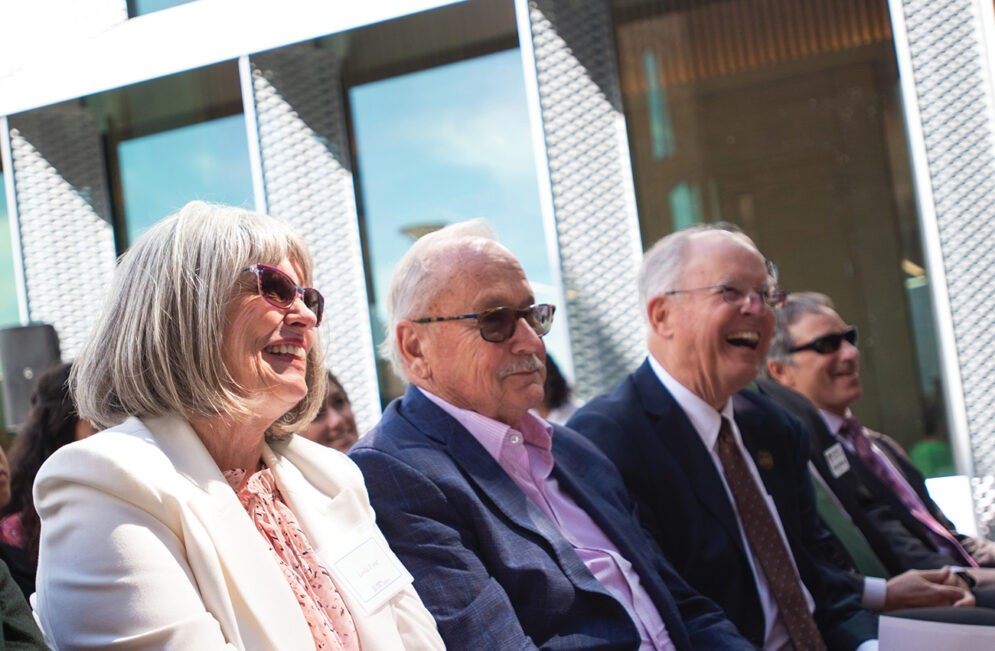
From left; Linda and Bill Frost, with emeritus dean Phil Bailey at the Frost Center dedication ceremony.
Funding the Vision
The Frost Center is named for Bill and Linda Frost, whose 2017 gift to the College of Science and Mathematics — the largest in CSU history — not only helped make the building possible, but has also funded student scholarships, research stipends and other research-related resources across the college.
Bill Frost graduated from Cal Poly in 1972 with a degree in biochemistry. While at Cal Poly, he began a lifelong friendship with Phil and Tina Bailey. “Phil’s vision for the college helped to inspire Bill and Linda Frost’s generosity to Cal Poly,” said President Armstrong at the building’s dedication ceremony. “Working closely with Phil through the years, the Frosts envisioned transforming students’ education at Cal Poly by greatly enhancing the resources for undergraduate research. The Frost Center is a testament to this partnership and an investment in the future successes of our students.”
Additional lead funding was provided by Jim and Suzanne Boswell, who made the Boswell Agricultural Technology Center possible; James A. and Felicia M. Cashin, who supported the Expressive Technology Studios; the California State University, Cal Poly Corporation, Taylor Farms, the Oreggia Family Foundation, George P. Johnson Experience Marketing, Affiliated Engineers, Inc., Research Facilities Design, and ZGF Architects.
The Alumni Who Built It
While the College of Architecture and Environmental Design (CAED) doesn’t have a formal presence in the Frost Center, CAED alumni were heavily involved in creating the facility.
Architect Ted Hyman, who graduated in 1979 with a B.S. in architecture, led the architectural team from the firm ZGF. This isn’t his first project at his alma mater: Hyman previously designed the Warren J. Baker Center for Science and Mathematics, and has also worked on many other educational facilities. He was an honored alumnus in 2014 and serves on the CAED Dean’s Leadership Council.
The laboratory design consulting firm Research Facilities Design, with principals Sean Towne and Jorge Garcia — both architecture alumni — was responsible for designing the laboratory spaces.
Kurt Clandening, of John A. Martin & Associates, served as a structural engineer on the project. He graduated from Cal Poly with his bachelor’s degree in architectural engineering in 1987 and earned a master’s degree at UC Berkeley.
Joni L. Janecki, a 1987 landscape architecture grad, leads the firm that designed the green spaces surrounding the building to be a functional part of the educational experience — including the Christina Bailey Learning Terrace, a rooftop garden atop the building’s west wing.
Read more about their approaches to the project, and other alumni who helped shape the Frost Center, in the 75th anniversary issue of CAED Connections.

Paul Anderson (left), Jean Davidson (right) and biology student Gianna Bozzo work in one of the labʼs collaborative breakout rooms.
Center for Computational Molecular Sciences
Computing a Better World
In the past year, artificial intelligence advances have been the subject of massive public attention. By quickly analyzing and synthesizing billions of pieces of data, popular AI tools can write compelling copy, generate spectacular artwork and convincingly simulate faces and voices.
But what if we turned that computing power to a higher- stakes task — like unlocking the mysteries of breast cancer, or creating genome-targeted, life-saving medications?
In the new Computational Molecular Sciences (CMS) lab at the Frost Center, three faculty members — biologist Jean Davidson, chemist Ashley McDonald and computer scientist Paul Anderson — are working together to apply machine learning tools to these incredibly complex problems.
“If you ask a human to sort through 100,000 nucleotides of a cancer genome and tell you which ones matter and which don’t, that’s impossible,” says Davidson. “If you ask a computer, it can easily do that. The dream is that I’m going to give that computer 3 billion nucleotides, and then see if the AI can find patterns and trends we’ve never seen before.”
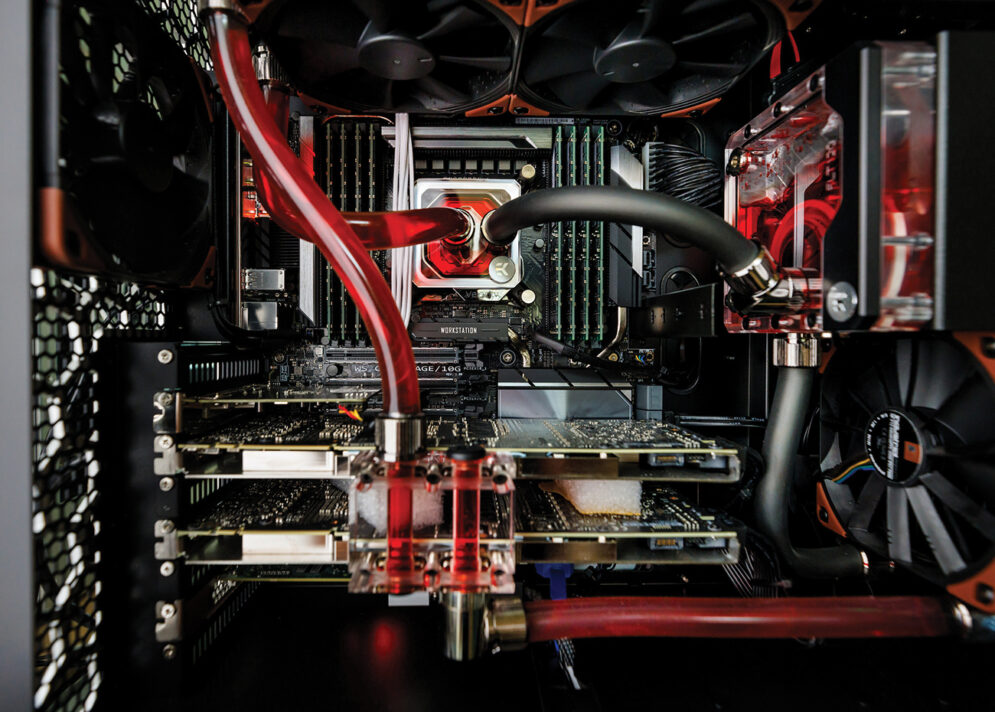
An inside look at one of the labʼs powerful computers.
To that end, the new lab includes three powerful custom- built computers designed to handle massive machine learning applications, which can be networked to run multiple data-intensive processes simultaneously. This specialized equipment includes state-of-the-art GPUs paired with more than 4 terabytes of memory and hundreds of CPU cores.
Perhaps even more crucially, the lab also features space for collaboration among student researchers from a variety of disciplines. That’s because the biggest challenge isn’t getting a powerful computer to find critical patterns in the data — it’s guiding the computer toward the patterns relevant to the issue at hand.
“Under-specification occurs when there are many distinct ways for an AI predictive system to achieve equivalent performance,” says Anderson. “This is a problem because if one AI system says a patient has cancer but another model disagrees, how do you decide which system to trust?”
That need for human expertise is why it’s so important that the lab brings so many different team members together, all of them supplying knowledge from their own areas to each challenge.
“The thing that the Frost Center really enables is putting all these students from different disciplines into the same room — physicists, biomedical engineers, chemical engineers, chemists, computer scientists,” says McDonald. “They have these interdisciplinary exchanges of knowledge, and I think it’s those interactions of cross-pollination between the students that are the most valuable.”
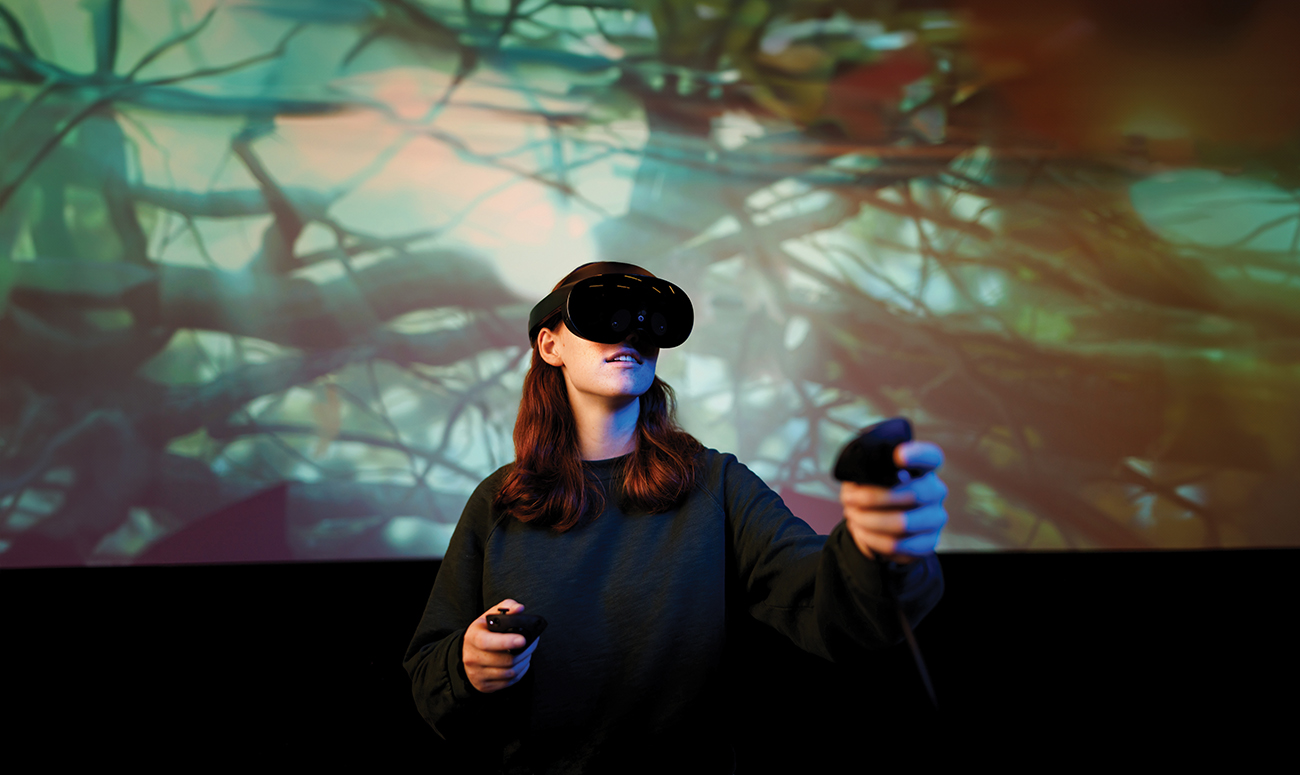
Student Alyse Murray tests out the studio’s virtual reality gear.
Cashin Expressive Technology Studios
The Future of Storytelling
The theater is silent and dark. The sound- absorbent tiles that cover the walls like a sprawling cityscape are barely visible, but they’re doing their job — the room is quiet enough that you can almost hear your own heartbeat.
Suddenly a 20-foot projection screen flares to life with the trailer for a sci-fi blockbuster. Your ears track the motion of the laser blasts flashing past you and spaceships scream overhead as the Dolby Atmos sound system kicks into action, projecting bone-shaking surround sound.
It’s not a Hollywood screening room — it’s a cutting-edge studio dedicated to teaching liberal arts and engineering (LAES) students the latest techniques in immersive audio and visual storytelling, and it’s on the ground floor of the Frost Center.
The space is already slated for lots of student and faculty research over the next few quarters.
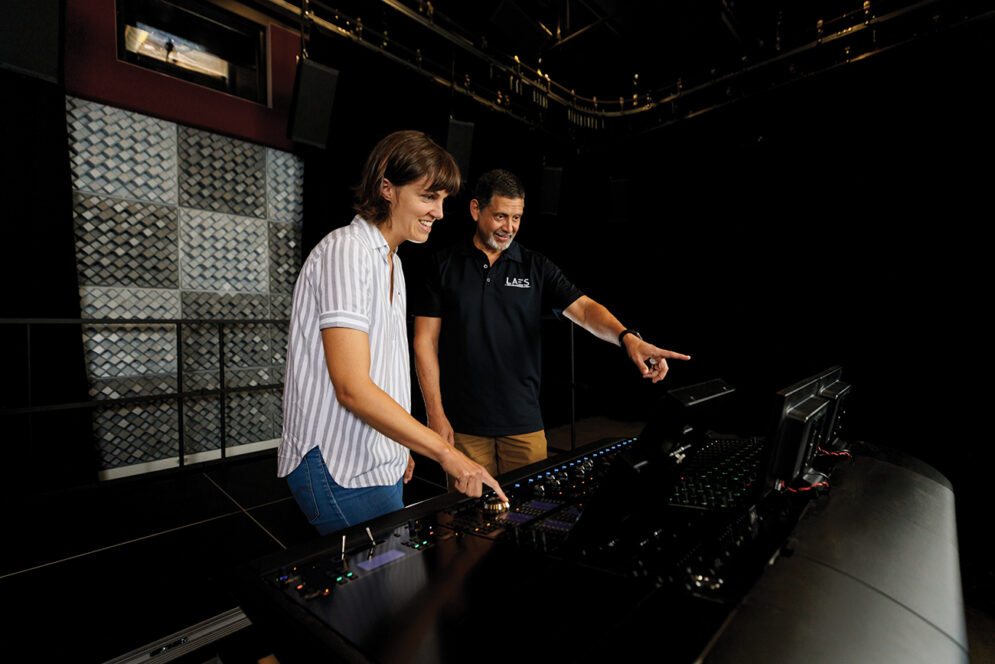
Music professor Julie Herndon and computer science professor and LAES co-director Michael Haungs work with the studio’s new sound mixing board.
Music professor Julie Herndon is using a research grant to develop a new musical interface that allows a performer to generate unique notes and sounds by touching everyday objects around them. The Theatre Department is using the studio’s Wi-Fi-based motion capture system to add live monster special effects to its winter production of Percy Jackson and the Lightning Thief. And a group of students are using the studio’s virtual- and augmented- reality equipment to create an immersive 3D virtual reality experience designed to transport elementary school students from the classroom to an undersea environment off the California coast.
The studio’s assets also include a projection room outfitted with a professional-quality digital projector; digital editing bays set up to handle traditional video editing or more complex virtual reality projects; and the upcoming installation of a customizable lighting grid that students will use to learn professional theater lighting.
But the most important thing the space provides to students is less tangible.
“These kind of production spaces are usually designed specifically for commercial use and are very hard to access unless you’re part of that whole system. You don’t just hand it over to people and let them play with it for months at a time and see what they can come up with,” says professor David Gillette, co-director of the LAES program. “But that’s exactly what we’re trying to create — an open space for students to experiment and try things. The tools are important, but tools are just tools. What they really need is the time and space and the freedom to experiment.”
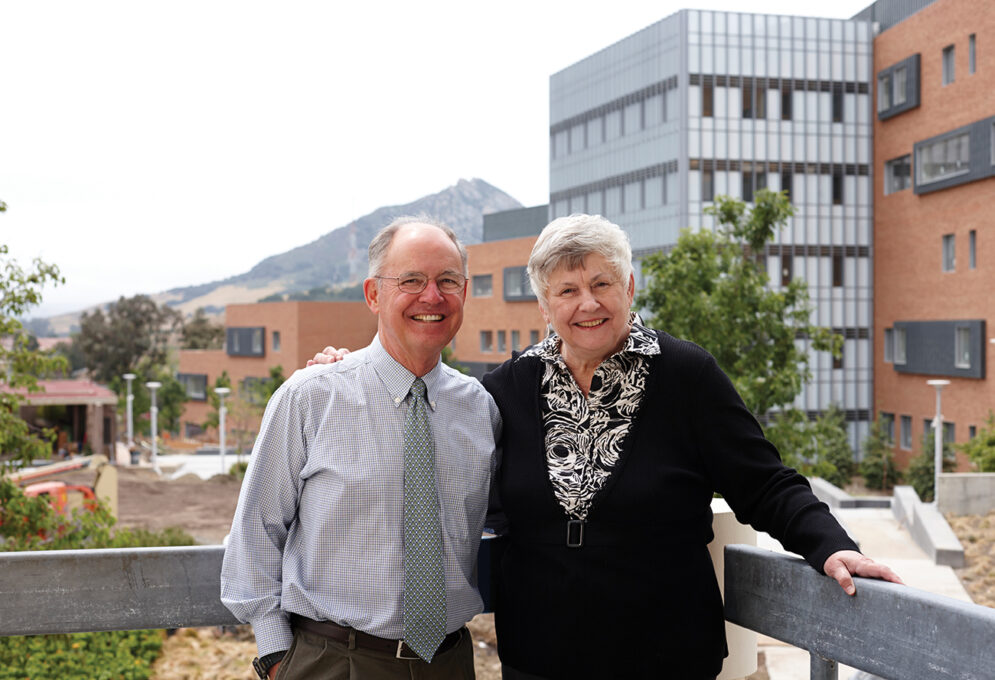 Introducing Bailey College
Introducing Bailey College
By Sarah Thien
As Cal Poly celebrated the future of innovation on campus during the Frost Center’s grand opening in May, the university also announced a new name for one of the colleges involved in the Frost Center: the Philip and Christina Bailey College of Science of Mathematics.
“It is impossible to overstate the positive impact Phil and Tina have had on Cal Poly and on the thousands of people they have mentored and inspired, including Bill and Linda Frost,” said President Jeffrey D. Armstrong.
Phil Bailey, longtime dean of the College of Science and Mathematics, retired in 2017 after 48 years of service to Cal Poly as a professor and dean of the College of Science and Mathematics. He was instrumental in working with the Frosts to develop their gift, and continues to serve Cal Poly through his work on the Cal Poly Foundation Board and as director of the Frost Fund. Tina Bailey, professor emerita and former chair of the Chemistry and Biochemistry Department, passed away in 2020. She taught at Cal Poly for more than 40 years and received national recognition for her development of the studio classroom model that integrates lecture and laboratory space.
“You can’t be successful in this job if you don’t have the support of people who really do the work — great staff and students,” said Phil Bailey of the honor. “It meant a lot to me, and I’m sure it would have to Tina as well.”
“We could think of no greater honor than to have our college named after Phil and Tina,” said Dean Wendt, dean of the Bailey College of Science and Mathematics. “This is a celebration of decades of work by the two of them to make this college and campus the incredible place that it is for students to learn and to grow and for faculty and staff to spend their careers.”


